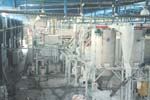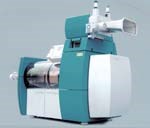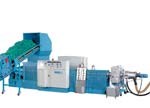Recycling at K 2001: New & Better Ways to Reclaim PET
Last fall's K 2001 show in Dusseldorf brought out new advances in bottle-to-bottle PET recycling.
Last fall's K 2001 show in Dusseldorf brought out new advances in bottle-to-bottle PET recycling. Two, in particular, address the key economic and technical issue of intrinsic viscosity (I.V.) in the end product. One technology is claimed to raise the scrap's I.V. without solid-stating, and another new process said to impart zero I.V. loss. Also reported here are new fiber-reclaiming systems and improved protection against tramp metal.
Hold onto your I.V.
Sorema of Italy (represented here by Common Sense Solutions, Chester, N.Y.) offers a new process licensed from Visy Recycling in Australia that takes PET from curbside commingled bottles and produces food-grade PET pellets. The process reportedly raises the flake's I.V. quickly and economically from 0.75 to 0.80 without solid-stating. (Solid-stating typically takes 16-20 hr in a vacuum reactor and is the big cost factor in bottle-to-bottle PET recycling.)
The Sorema/Visy process, called Ekopet, can recycle 15 million lb/yr. It has been run commercially for two years at a rate of 1100 lb/hr. Ekopet material is guaranteed to contain less than 10 ppb of potential contaminants. It received FDA non-objection status last June.
Sorema builds Ekopet components for bottle sorting, washing, wet grinding, and intensive flake washing in a surfactant solution for a specific time at specific temperatures (170 to 212 F). Cleaned flake then goes through a conventional crystallizing dryer and into a modified twin-screw extruder with multiple vacuum vents. Visy has applied for a patent on the whole sequence from curbside collection of commingled PET bottles to producing a high-I.V., bottle-grade pellet.
The Ekopet process is not the first to restore bottle-grade I.V. without solid-stating. In 2000, Erema GmbH of Austria (U.S. office in Ipswich, Mass.) came out with the Vacurema method of raising RPET's I.V. from 0.76 to 0.80 without solid-stating. This material also has FDA non-objection status. Erema combines predrying and crystallizing with a proprietary "vacuum reactor" or densifier. This TE-VS reactor is fed continuously via an airlock door that opens and closes to allow new flake to enter. It holds flake for about 1 hr and feeds flake continuously into a single-screw extruder.
Used alone, the Vacurema reactor prevents I.V. degradation during extrusion, according to Erema. If flake is first predried and crystallized to less than 0.5% moisture, the reactor can then raise the I.V. to bottle-grade level. Erema has three customers using the dryer-reactor combination for bottle-to-bottle recycling. One is PET bottle producer Schmalbach-Lubeca in France.
Meanwhile, the Kreyenborg Group of Germany (U.S. office in Lawrenceville, Ga.) offers an innovative Infrared Rapid Dryer, built by Siac GmbH in Germany and exclusively licensed to Kreyenborg for plastic recycling. This device crystallizes and dries PET flake using selected IR wavelengths that are strongly absorbed by moisture. Dried flake is then transported under vacuum to a densifier, where other volatiles are removed before it moves on to a vacuum-vented twin-screw extruder. The densifier stage can actually add 0.01 I.V. units, and tight control of the extruder reportedly results in zero I.V. loss in extrusion. So with 0.78 I.V. flake going into the system, material could come out, at least in theory, with 0.79 I.V.
Lots of vacuum & washing
Luigi Bandera SpA in Busto Arsizio, Italy, showed a new high-vacuum venting approach to reprocessing scrap PET. The firm's corotating twin-screw extruder has 170-mm-diam. screws and up to three vents—two high-vacuum, one ambient. It processes up to 3000 lb/hr of PET (or twice as much PP). The model on display was also the biggest machine for PET extrusion Bandera has built to date. (Previously, its biggest was 135 mm.) With three vents, the extruder reportedly lowers PET I.V. by 0.0670 units.
Weiss GmbH in Dillenburg, Germany, is new in PET recycling. Its first line will be installed this year in Poland to reprocess PET bottles. The line starts with bale breaking, conveying to a sorting table, cutting (in a Rapid grinder), and air separation of labels. Then come four washing steps: First, a wash auger, followed by a high-friction washer with rotating blades, then three more wash augers with surfactants, three rinse augers, float/sink separation, and finally mechanical drying. Kreyenborg will supply the dryer and extruder for the Polish plant.
News in fiber recycling
Erema brought out its first system that can recycle baled fibers and film, tangled tapes, or lumps of PET, PP, and nylon without precutting. The Coax 300E combines a single-shaft shredder and single-screw extruder in a coaxial arrangement with a single 175-hp drive. The hopper has an unusual segmented feeder-pusher that allows changing the intake angle of the shredder for materials of different shapes and bulk densities. The shredder housing has spiral grooves that help feed chopped material directly into the coaxial extruder without using large amounts of costly compressed air. The Coax 300 has a 4.75-in., 35:1 extruder with double vents and output range of 594 to 880 lb/hr. Two smaller models handle 220 to 550 lb/hr. Specific energy consumption is said to be 0.11 to 0.15 kwh/lb.
Next Generation Recyclingmaschinen GmbH, Marchtrenk, Austria (which has several U.S. representatives), ran the first demonstration at a show of fiber recycling, using a new model of its NGR series cutter-feeder-extruder combination. The integrated unit handles fiber without precutting, using an "intelligent" feeder that monitors the shredder shaft load and adjusts the crammer feed accordingly. Friction from the cutting chamber preheats the flakes before they enter the vented extruder. The company showed its new small "A Class" model, which uses one drive for both shredder and extruder. Larger versions have separate drives.
Get the metal out
S+S Metal Separation and Recycling GmbH in Germany (parent of S+S Metal Detectors North America, Schnecksville, Pa.) brought out a new system for metal detection and removal from ground flake. It senses ferrous and nonferrous metals, even if encapsulated in plastic. As the flake falls through a vertical pipe, it passes a metal detector above a "Y" junction. If metal is present, a fast-acting solenoid valve opens a gate to divert the contaminated material while minimizing loss of clean flake. This Rapid 4000 system has very low overall height.
Related Content
How to Extrusion Blow Mold PHA/PLA Blends
You need to pay attention to the inherent characteristics of biopolymers PHA/PLA materials when setting process parameters to realize better and more consistent outcomes.
Read MoreRecycling: What's Ahead in Advanced Sorting Technology
As the industry tries to ramp up recycling, there are several innovative sorting solutions in the offing—ranging from enhanced optical sorting technologies and chemical tracers to advanced solutions based digital watermarks and artificial intelligence.
Read MoreProcessing Megatrends Drive New Product Developments at NPE2024
It’s all about sustainability and the circular economy, and it will be on display in Orlando across all the major processes. But there will be plenty to see in automation, AI and machine learning as well.
Read MoreFoam-Core Multilayer Blow Molding: How It’s Done
Learn here how to take advantage of new lightweighting and recycle utilization opportunities in consumer packaging, thanks to a collaboration of leaders in microcellular foaming and multilayer head design.
Read MoreRead Next
How Polymer Melts in Single-Screw Extruders
Understanding how polymer melts in a single-screw extruder could help you optimize your screw design to eliminate defect-causing solid polymer fragments.
Read MoreAdvanced Recycling: Beyond Pyrolysis
Consumer-product brand owners increasingly see advanced chemical recycling as a necessary complement to mechanical recycling if they are to meet ambitious goals for a circular economy in the next decade. Dozens of technology providers are developing new technologies to overcome the limitations of existing pyrolysis methods and to commercialize various alternative approaches to chemical recycling of plastics.
Read MoreProcessor Turns to AI to Help Keep Machines Humming
At captive processor McConkey, a new generation of artificial intelligence models, highlighted by ChatGPT, is helping it wade through the shortage of skilled labor and keep its production lines churning out good parts.
Read More





























